Change in Conductive–Radiative Heat Transfer Mechanism Forced by Graphite Microfiller in Expanded Polystyrene Thermal Insulation—Experimental and Simulated Investigations
Abstract
1. Introduction
- -
- How can we overcome the experimental artefact of the thickness effect, as revealed by conventional polymeric foam panels?
- -
- How can we find the true conductivity λ and resistance R values for the panels which are thicker than the gauge of plate instruments?
2. Materials and Methods
2.1. Tested Products
- -
- “white” EPS A—pure;
- -
- “dotted” EPS B—with a low concentration of GMP (only within the expanded beads of the black dotted isles, scattered randomly in the entire panel); and
- -
- “grey” EPS C—with a high concentration of GMP (evenly distributed throughout the polymer matrix and in the entire panel).
2.2. Experimental Limitations for Thermal Measurement
2.3. Bulk Density Measurement Method
- -
- the panel mass, with an accuracy of ±10−5 kg,
- -
- the panel dimensions (length x and width y), with an accuracy of ±5 × 10−4 m; and thickness d, with an accuracy of ±10−6 m,
- -
- the panel volume (as a regular rectangular prism), with accuracy no worse than ±10−4 m3 and
- -
- the panel density (as the mass to volume ratio) and the bulk density of the material (as an average over the thickness range), with accuracy no less than ±2 × 10−1 kg·m−3.
2.4. Thermal Measurement Method
2.4.1. The Thickness Effect and Thickness Limit of (Non-)Linearity
2.4.2. HFM Setup
2.4.3. Conductivity-Resistance Measurement Method
Standard Method
- -
- the sample thickness d, with accuracy Δd of ±10−6 m;
- -
- the temperature difference ΔT between upper and lower sample surfaces, with accuracy Δ(ΔT) of ±0.1 °C;
- -
- the heat flux density q through the sample, with accuracy Δq of ±10−1 W·m−2;
- -
- the apparent thermal resistance R′, with accuracy ΔR′ of ±10−4 m2·K·W−1; and
- -
- the apparent thermal conductivity coefficient λ′, with accuracy Δλ′ of ±10−5 W·m−1·K−1.
Nonstandard Method
2.5. Micro-Raman Measurement
2.6. Thermal Analysis Measurement
3. Experimental Results
3.1. Bulk Density and Homogeneity Assessment
3.2. Thickness Limits Results
3.3. The Thermal Conductivity Results
3.4. The Thermal Resistance Results
3.5. Micro-Raman Spectra of Tested Products
3.6. Thermal Analysis of Tested Products
4. Discussion
4.1. Thermal Conductivity Analysis
4.1.1. Relationship between Thickness Effect and Density
4.1.2. GMP Effect
- -
- radiation (through both solid matrix and air),
- -
- solid matrix conduction, and
- -
- gas conduction (air thermal conductivity without radiation).
4.1.3. Further Explanation of the Thickness Effect
5. Conclusions and Evaluation
- Initial testing of EPS product quality should be a homogeneity assessment, which can be based either on bulk density or thermal conductivity measurements versus thickness. This is possible due to the observed ρ(d) and corrected λ(d) synchronizing and the experimental relationship of λ(ρ) between the density and corrected conductivity functions. Absence of data scattering and constant level indicates good quality. The worst homogeneity was found for the “white” EPS A product of poor quality, possibly due to recycling process used during production. The “dotted” EPS B and “grey” C products revealed good homogeneity. As the poor homogeneity may have a great impact on all thermal measurements and material characteristics, the EPS A product had to be excluded from further analysis.
- The analysis and evolution of the total thermal conductivity components versus the EPS panel thickness in the range of 0.02–0.1 m, for two different GMP concentrations (which are applied industrially): low (“dotted”) and high (“grey”) were described. The EPS materials from which the panels were made had comparable and very low bulk densities, from 14 to 15 kg·m−3. The simulated data for the “dotted” EPS B and “grey” EPS C products are presented in Table 5 and plotted in Figure 8. The analysis was carried out by combining experimental measurements (HFM Fox 600) and literature data (HFM Fox 314) [42]. Simulation of the thermal radiation component was carried out through the above data processing, which was used to separate all thermal conductivity components (radiation, air conduction, and matrix conduction), as plotted in Figure 9. A lack of convection was assumed, due to the EPS closed-cell structure. The percentage contributions of all thermal components were then calculated.
- In EPS materials that differ in GMP concentration (“dotted” and “grey”), the percentage contribution of the polymer matrix thermal conduction component and the thermal radiation component in the total thermal conductivity vary with the thickness of the thermal insulating layer in both product types. In detail, we noticed the following main points (Table 5):
- In the “dotted” EPS B at the smallest panel thickness (up to the thickness limit value), the thermal radiation component reached its highest percentage contribution in the total heat transport. At the smallest thickness (of 0.02 m), the thermal radiation contribution was 10.8% (corrected data in brackets). The thermal radiation contribution decreased with an increase of the panel thickness. Above the thickness limit, the contribution of the thermal radiation component was negligible and, at the highest available thickness of 0.1 m, it was only 2.3% (corrected data in brackets). On the contrary, the contribution of the solid matrix thermal conduction component increased with an increase of panel thickness. The contributions of the polymer matrix thermal conduction component were 22.9% and 31.2% (corrected data in brackets) for the 0.02 and 0.1 m panels, respectively; and
- In the “grey” EPS C, regardless of the panel thickness, the thermal radiation component was negligible. The percentage contribution of the polymer matrix thermal conduction component was 18.8% in the 0.02 m panels. The contribution increased with thickness and reached 20.4% at the highest panel thickness (0.1 m).
- As resulted, adding GMP in high industrial concentrations as in “grey” EPS material may force a change in the radiative–conductive heat transfer mechanism; yet, it does not cause a perceivable decrease of the air conduction contribution. Based on the analysis results presented in Table 5, unfortunately, the percentage contributions in both the “dotted” EPS B and “grey” C products at the smallest panel thickness (0.02 m) can reach up to 70% and 81% and at the highest panel thickness (0.1 m), to about 66% and 80%, respectively. In order to reduce air conduction contribution, one may apply volume compression during foam manufacturing, as in the case of XPS foam production [65]. Such volume compression may be realized in combination with cell morphology regulation by altering the cell orientation (in one preferred spatial direction) and cell anisotropy (of 3D form), as compared with substantially round celled materials [66]. Additionally, one may reduce the cell size to obtain nanocellular PS foams [67,68].
- The comparison of EPS materials (“dotted” and “grey”), regarding their distributions of percentage contributions of thermal conductivity components (Table 5, e.g., the “dotted” EPS B and “grey” C products) at the highest panel thickness (0.10 m), showed a dramatic effect of change in thermal radiation, by nearly −100% (i.e., (0–0.023)/0.023 × 100%). Furthermore, the polymer matrix thermal conduction was reduced strongly, by c.a. 35% (i.e., (0.203–0.312)/0.312 × 100%). One may conclude that the incorporation of GMP implicates elimination of the thermal radiation. It also considerably weakens the polymer matrix thermal conduction, especially for large thickness panels, as the contribution of the matrix conduction becomes substantial for panels above the thickness limit. In general, the results indicate that the higher the thickness, the greater the reduction effect of matrix thermal conduction.
- The apparent evolution of all thermal conductivity components was found in the analysis, based on measured and simulated data for EPS materials of two different GMP industrial concentrations (“dotted” and “grey”). In order to confirm the observed effects, verification may be required in terms of additional measurements. Yet, the trends revealed in this experiment are not expected to radically change.
- As shown in Figure 6, the GMP addition to the polystyrene matrix (as in “grey” EPS C) leads to polymer matrix structural modification processes, resulting in significant attenuation of phonon spectra characteristic of pure matrix (as in “white” EPS material). This directly supports the observed drop in matrix thermal conduction component (Figure 9) and thereby explains the decrease in total thermal conductivity of EPS insulation (Figure 8). It is well known that the graphite’s thermal conductivity is very high. However, based on Raman spectra, we can conclude that the addition of GMP does not lead to a simple mixture of graphite and polystyrene. In the Raman spectrum of the matrix of the EPS C, there are no modes characteristic for graphite. It should be assumed that we are dealing with particular intermolecular interactions between graphite particles and polystyrene, leading to a structurally modified/disturbed polymer matrix.
- The thermal isolation of required resistance can be designed, regarding EPS “grey”, rather than EPS “dotted” or EPS “white” panels, of reduced thickness (0.18–0.30 m) and at comparable density to EPS materials. In building practice, this means that the highest achievable reduction of at least 18.3% in the EPS insulating layer thickness is possible, referring to the thickest 0.30 m “dotted” EPS B or even “white” EPS panels.
Supplementary Materials
Author Contributions
Funding
Acknowledgments
Conflicts of Interest
The List of Symbols and Abbreviations
| Symbols and Abbreviations | Meanings | Units |
| <…> | – distinguishing symbol for a physical quantity averaged over thickness range | |
| A | – “white” (pure) EPS product, tested herein or elsewhere in literature | |
| B | – “dotted” EPS product, tested herein | |
| dotted | – “dotted” EPS product, tested elsewhere [42] | |
| C | – “grey” EPS product, tested herein | |
| grey | – “grey” EPS product, tested elsewhere [42] | |
| – correction parameter (Table 1) | (W·m−1·K−1) | |
| CEN | – European Committee for Standardization | |
| DSC | – differential scanning calorimetry | |
| TGA | – thermogravimetric analysis | |
| d | – thickness (height) of the panel or sample | (m) |
| dA, dB, dC | – thickness of the panel or sample referring to product A, B, or C, respectively | |
| dmax | – maximum permissible thickness of the sample assigned to the chamber of specified dimensions of the plate instrument | (m) |
| dmin | – minimum permissible thickness of the sample assigned to the chamber of specified dimensions of the plate instrument | (m) |
| dL | – the panel thickness limit of the R′ and λ′ (non-)linearity | (m) |
| dLA, dLB, dLC | – the thickness limit referring to product A, B, or C, respectively | |
| EPS/XPS | – expanded/extruded polystyrene | |
| GFMs | – gas-filled materials | |
| GHP | – guarded hot plate instrument | |
| GMP | – graphite microparticles | |
| HFM | – heat flow meter instrument | |
| k | – coverage factor used in statistical analysis | |
| L | – thickness effect parameter | |
| µ-RS | – micro-Raman spectroscopy | |
| m | – measured mass | (kg) |
| NIMs | – nanoinsulation materials | |
| PCMs | – phase change materials | |
| PhF | – phenolic foam | |
| PIR | – polyisocyanurate | |
| PS | – polystyrene | |
| PUR | – polyurethane | |
| q | – density of heat flux through an insulation panel | (W·m−2) |
| R0 | – extrapolated thermal resistance corresponding to panel thickness d = 0, in particular referring to product A, B, or C, respectively (after correction) | (m2·K·W−1) |
| R0A, R0B, R0C | ||
| R′0 | – extrapolated thermal resistance corresponding to panel thickness d = 0, in particular referring to product A, B, or C, respectively (before correction) | (m2·K·W−1) |
| R′0A, R′0B, R′0C | ||
| R | – corrected thermal resistance (obtained by converging the corrected λ for a given panel thickness d) | (m2·K·W−1) |
| RA, RB, RC | – corrected thermal resistances referring to product A, B, or C, respectively | |
| R′ | – apparent thermal resistance (as measured for a given panel thickness d) | (m2·K·W−1) |
| R′A, R′B, R′C | – apparent thermal resistance referring to product A, B, or C, respectively | |
| RD | – declared thermal resistance at Tm = 10 °C (assigned by a manufacturer to each panel of thickness d) | (m2·K·W−1) |
| RDA, RDB, RDC | – declared thermal resistance referring to product A, B, or C, respectively | |
| SIMs | – super insulating materials | |
| SRM | – standard reference material | |
| TDS | – technical data sheet provided by the manufacturer | |
| Tcm | – crystalline melting temperature | (°C) |
| Tg | – glass transition temperature | (°C) |
| Tm | – average measurement (test) temperature | (°C) |
| U-value | – thermal transmittance (overall heat transfer coefficient) | (W·m−2·K−1) |
| VIMs | – vacuum insulation materials | |
| x, y | – panel dimensions: length, width | (m) |
| ΔT | – temperature difference between the “hot” and “cold” plates | (°C) |
| λ | – corrected thermal conductivity coefficient (resulted after correction of λ′ for a given panel of thickness d) | (W·m−1·K−1) |
| λA, λB, λC | – corrected thermal conductivity coefficient referring to product A, B, or C, respectively | |
| λ′ | – apparent thermal conductivity coefficient (as measured without Al-foil for a given panel thickness d) | (W·m−1·K−1) |
| λ′A, λ′B, λ′C, λ′dotted, λ′grey | – apparent thermal conductivity coefficient for a given product (as measured without Al-foil) | |
| λ″ | – apparent thermal conductivity coefficient (as simulated or measured with Al-foil for a given panel thickness d) | |
| λ″A, λ″B, λ″C, λ″dotted, λ″grey | – apparent thermal conductivity coefficient for a given product (as simulated or measured with Al-foil) | |
| λD | – thermal conductivity coefficient at Tm = 10 °C, as declared by a manufacturer (independent on thickness d) | (W·m−1·K−1) |
| λDA, λDB, λDC | – declared thermal conductivity coefficient referring to product A, B, or C, respectively | |
| λCSRM | – SRM thermal conductivity coefficient (given in the Certificate for Tm = 10 °C) | (W·m−1·K−1) |
| λMSRM | – SRM thermal conductivity coefficient (measured with HFM FOX 600 at Tm = 10 °C) | (W·m−1·K−1) |
| λt | – thermal transmissivity, horizontal asymptote of λ(d), reciprocal gradient of the R(d) linear fit (after correction) | (W·m−1·K−1) |
| λtA, λtB, λtC | – thermal transmissivity, referring to product A, B, or C, respectively | |
| λ′t | – thermal transmissivity, horizontal asymptote of λ′(d), reciprocal gradient of the R′(d) oblique asymptote (before correction) | (W·m−1·K−1) |
| λ′tA, λ′tB, λ′tC | – thermal transmissivity referring to product A, B, or C, respectively | |
| ρ | – bulk density of polymeric insulation material (very low or low) | (kg·m−3) |
| ρA, ρB, ρC | – bulk density value of product A, B, or C, respectively | |
| ℑ | – heat transfer factor, the effective conductivity coefficient (Supplementary Material part 1) | (W·m−1·K−1) |
| ℑA, ℑB, ℑC | – heat transfer factor referring to product A, B, or C, respectively | |
| Uncertainty | ||
| Δ | – absolute error, accuracy or absolute change of a quantity | |
| U() | – expanded uncertainty of the correction parameter in the calculation of | (W·m−1·K−1) |
| U(d) | – expanded uncertainty of the sample thickness measurement in HFM FOX 600 | (m) |
| U(L) | – expanded uncertainty of the thickness effect parameter calculation | |
| U(m) | – expanded uncertainty of the mass measurement | (kg) |
| U(q) | – expanded uncertainty of the heat flux density measurement | (W·m−2) |
| U(x) or U(y) | – expanded uncertainty of the x, y dimensions measurement | (m) |
| U(ΔT) | – expanded uncertainty of the temperature difference measurement | (°C) |
| U(λ) | – expanded uncertainty in determination of the thermal conductivity coefficient λ | (W·m−1·K−1) |
| U(λ′) | – expanded uncertainty in measurement of the thermal conductivity coefficient λ′ | (W·m−1·K−1) |
| U(λ)/λ | – relative expanded uncertainty in determination of the thermal conductivity coefficient λ | (%) |
| U(λ′)/λ′ | – relative expanded uncertainty in measurement of the thermal conductivity coefficient λ′ | (%) |
| U(λCSRM) | – expanded uncertainty in determination of the SRM thermal conductivity coefficient λCSRM (given in the Certificate for Tm = 10 °C) | (W·m−1·K−1) |
| U(λMSRM) | – expanded uncertainty in measurement of the SRM thermal conductivity coefficient λMSRM (measured with HFM FOX 600 at Tm = 10 °C) | (W·m−1·K−1) |
| U(ρ) | – expanded uncertainty of the bulk density measurement | (kg·m−3) |
| U(ρ)/ρ | – relative expanded uncertainty of the bulk density measurement | (%) |
| σ | – standard deviation | |
References
- Suh, K.W. Polystyrene and Structural Foam. In Handbook of Polymeric Foams and Foam Technology: Polystyrene and Structural Foam, 2nd ed.; Klempner, D., Sendijarevic, V., Eds.; Hanser: Munich, Germany, 2004; pp. 189–225. [Google Scholar]
- Pfundstein, M.; Gellert, R.; Spitzner, M.; Rudolphi, A. Detail Practice: Insulating Materials: Principles, Materials, Applications, 1st ed.; Birkhäuser: Basel, Switzerland, 2008. [Google Scholar]
- Gray, J.E. Polystyrene: Properties, Performance and Applications, 1st ed.; Nova Science Publishers Inc.: New York, NY, USA, 2011. [Google Scholar]
- Polystyrene. Available online: https://www.sciencedirect.com/topics/materials-science/polystyrene (accessed on 1 September 2019).
- Gibson, L.J.; Ashby, M.F. Cellular Solids: Structure and Properties, 2nd ed.; Gibson, L.J., Ashby, M.F., Eds.; Cambridge University Press: Cambridge, UK, 1997. [Google Scholar]
- Simmler, H.; Brunner, S.; Heinemann, U.; Schwab, H.; Kumaran, K.; Mukhopadhyaya, P.; Quénard, D.; Sallée, H.; Noller, K.; Kücükpinar–Niarchos, E.; et al. Vacuum Insulation Panels. Study on VIP—Components and Panels for Service Life Prediction of VIP in Building Applications (Subtask A), IEA/ECBCS Annex 39 HiPTI—High Performance Thermal Insulation (2005). Available online: https://www.osti.gov/etdeweb/biblio/21131463 (accessed on 1 September 2019).
- Jelle, B.P.; Gustavsen, A.; Baetens, R. The path to the high performance thermal building insulation materials and solutions of tomorrow. J. Build. Phys. 2010, 34, 99–123. [Google Scholar] [CrossRef]
- Fantucci, S.; Lorenzati, A.; Kazas, G.; Levchenko, D.; Serale, G. Thermal Energy Storage with Super Insulating Materials: A Parametrical Analysis. Energy Procedia 2015, 78, 441–446. [Google Scholar] [CrossRef]
- Al–Homoud, M.S. Performance characteristics and practical application of common building thermal insulation materials. Build. Environ. 2005, 40, 353–366. [Google Scholar] [CrossRef]
- Papadopoulos, M.A. State of the art in thermal insulation materials and aims for future developments. Energy Build. 2005, 37, 77–86. [Google Scholar] [CrossRef]
- Domínguez–Muñoz, F.; Anderson, B.; Cejudo–López, J.; Carrillo–Andrés, A. Uncertainty in the thermal conductivity of insulation materials. Energy Build. 2010, 42, 2159–2168. [Google Scholar] [CrossRef]
- Jelle, P.B. Traditional, state–of–the–art and future thermal building insulation materials and solutions—Properties, requirements and possibilities. Energy Build. 2011, 43, 2549–2563. [Google Scholar] [CrossRef]
- Directive 2010/31/EU of the European Parliament and of the Council of 19 May 2010 on the Energy Performance of Buildings. Available online: https://eur-lex.europa.eu/legal-content/en/TXT/?uri=celex%3A32010L0031 (accessed on 1 September 2019).
- Chung, D.D.L. Review Graphite. J. Mater. Sci. 2002, 37, 1475–1489. [Google Scholar] [CrossRef]
- Muzyka, R.; Drewniak, S.; Pustelny, T.; Chrubasik, M.; Gryglewicz, G. Characterization of Graphite Oxide and Reduced Graphene Oxide Obtained from Different Graphite Precursors and Oxidized by Different Methods Using Raman Spectroscopy. Materials 2018, 11, 1050. [Google Scholar] [CrossRef] [PubMed]
- Jara, A.D.; Betemariam, A.; Woldetinsae, G.; Kim, J.Y. Purification, application and current market trend of natural graphite: A review. Int. J. Min. Sci. Technol. 2019, 29, 671–689. [Google Scholar] [CrossRef]
- Causin, V.; Marega, C.; Marigo, A.; Ferrara, G.; Ferraro, A. Morphological and structural characterization of polypropylene/conductive graphite nanocomposites. Eur. Polym. J. 2006, 42, 3153–3161. [Google Scholar] [CrossRef]
- Tu, H.; Ye, L. Thermal conductive PS/graphite composites. Polym. Adv. Technol. 2009, 20, 21–27. [Google Scholar] [CrossRef]
- Glueck, G.; Batscheider, K.-H.; Riethues, M.; Schmitt, H. Polystyrene Foam Beads, Useful for the Production of Drainage Sheets for Cellar and Structural Walls. DE 19828250A1. 30 December 1999. Available online: https://worldwide.espacenet.com/patent/search/family/007871933/publication/DE19828250A1?q=DE%2019828250A1 (accessed on 1 September 2019).
- Glueck, G.; Hahn, K.; Batscheider, K.-H.; Naegele, D.; Kaempfer, K.; Husemann, W.; Hohwiller, F. Method for Producing Expandable Styrene Polymers Containing Graphite Particles. US6130265A, 10 October 2000. [Google Scholar]
- Glück, G.; Hahn, K.; Kaempfer, K.; Naegele, D.; Braun, F. Expandable Styrene Polymers Containing Graphite Particles. US6340713B1, 22 January 2002. [Google Scholar]
- Gluck, G. Expandable Styrene Polymers Containing Carbon Particles. US20040039073A1, 26 February 2004. [Google Scholar]
- Datko, A.; Hahn, K.; Allmendinger, M. Expanded Styrene Polymers Having A Reduced Thermal Conductivity. US8173714B2, 8 May 2012. [Google Scholar]
- Zhang, C.; Li, X.; Chen, S.; Yang, R. Effects of polymerization conditions on particle size distribution in styrene-graphite suspension polymerization process. J. Appl. Polym. Sci. 2016, 133, 44270. [Google Scholar] [CrossRef]
- Kondratowicz, F.L.; Rojek, P.; Mikoszek-operchalska, M.; Utrata, K. Combination of Silica and Graphite and Its Use for Decreasing the Thermal Conductivity of Vinyl Aromatic Polymer foam. US20180030231A1, 1 February 2018. [Google Scholar]
- Hohwiller, F. Neopor ®, A New EPS-Generation. In Proceedings of the Conference Particle Foam 2000, Wiesloch, Germany, 10–11 May 2000; p. 169. Available online: https://www.tib.eu/de/suchen/id/TIBKAT%3A312103158/Particle-foam-2000/ (accessed on 1 September 2019).
- Schellenberg, J.; Wallis, M. Dependence of Thermal Properties of Expandable Polystyrene Particle Foam on Cell Size and Density. J. Cell. Plast. 2010, 46, 209–222. [Google Scholar] [CrossRef]
- ISO:EN 8301:1991 Thermal insulation–Determination of Steady–State Thermal Resistance and Related Properties–Heat Flow Meter Apparatus. Available online: https://www.iso.org/standard/15421.html (accessed on 1 September 2019).
- ISO:EN 8301:2010 Amendment 1 Thermal insulation–Determination of Steady—State Thermal Resistance and Related Properties—Heat Flow Meter Apparatus. Available online: https://www.iso.org/standard/15421.html (accessed on 1 September 2019).
- EN 1946-3:1999 Thermal Performance of Building Products and Components—Specific Criteria for the Assessment of Laboratories Measuring Heat Transfer Properties—Part 3: Measurement by Heat Flow Meter Method. Available online: https://shop.bsigroup.com/ProductDetail?pid=000000000019973656 (accessed on 1 September 2019).
- CEN:EN 13172:2012 Thermal insulation Products–Evaluation of Conformity. Available online: https://standards.cen.eu/dyn/www/f?p=204:110:0::::FSP_PROJECT,FSP_ORG_ID:34678,6071&cs=1AE67E7D596D1D5F55D18830615383105 (accessed on 1 September 2019).
- CEN:EN 13163:2012 and CEN: EN 13163:2008 Thermal Insulation Products for Buildings—Factory Made Expanded Polystyrene (EPS) Products–Specification. Available online: https://standards.cen.eu/dyn/www/f?p=204:110:0::::FSP_PROJECT,FSP_ORG_ID:62941,6071&cs=13DF8DF21FF2A47C751908A6DC15AFAA4 (accessed on 1 September 2019).
- ISO:EN 9288:1996 Thermal Insulation—Heat Transfer by Radiation—Physical Quantities and Definitions (ISO 9288:1989). Available online: https://www.iso.org/standard/16943.html (accessed on 1 September 2019).
- Tleoubaev, A. Conductive and Radiative Heat Transfer in Insulators, TA Instruments Portal. Available online: http://www.tainstruments.com/pdf/literature/Conductive%20and%20Radiative%20Heat%20Transfer%20in%20Insulators.pdf (accessed on 1 September 2019).
- CEN:EN 12939:2000 Thermal Performance of Building Materials and Products—Determination of Thermal Resistance by Means of Guarded Hot Plate and Heat Flow Meter Methods—Thick Products of High and Medium Thermal Resistance. Available online: https://standards.cen.eu/dyn/www/f?p=204:110:0::::FSP_PROJECT,FSP_ORG_ID:2296,6072&cs=1745C3AD11A87A7F7BC47527DA6D98D88 (accessed on 1 September 2019).
- CEN:EN 12667:2001 Thermal Performance of Building Materials and Products—Determination of Thermal Resistance by Means of Guarded Hot Plate and Heat Flow Meter Methods—Products of High and Medium Thermal Resistance. Available online: https://standards.cen.eu/dyn/www/f?p=204:110:0::::FSP_PROJECT,FSP_ORG_ID:2314,6072&cs=1D562318E1F7D2D1B6702D7070657863D (accessed on 1 September 2019).
- Firkowicz–Pogorzelska, K. Transport ciepła przez promieniowanie w lekkich materiałach termoizolacyjnych/in Polish/, Materiały konferencyjne. In Proceedings of the VI Ogólnopolska Konferencja Naukowo–Techniczna Energodom 2002. Problemy projektowania, realizacji i eksploatacji budynków o niskim zapotrzebowaniu na energię, Kraków–Zakopane, Poland, 13–16 October 2002; pp. 83–90. [Google Scholar]
- Coquard, R.; Baillis, D. Modeling of Heat Transfer in Low-Density EPS Foams. J. Heat Transf. 2006, 128, 538–549. [Google Scholar] [CrossRef]
- Baillis, D.; Coquard, R. Radiative and Conductive Thermal Properties of Foams. In Cellular and Porous Materials: Thermal Properties Simulation and Prediction, 1st ed.; Öchsner, A., Murch Graeme, E., de Lemos, M.J.S., Eds.; Wiley-VCH Verlag GmbH & Co. KGaA: Weinheim, Germany, 2008; pp. 343–384. [Google Scholar] [CrossRef]
- Coquard, R.; Baillis, D.; Quenard, D. Radiative Properties of Expanded Polystyrene Foams. J. Heat Transf. 2009, 131, 012702. [Google Scholar] [CrossRef]
- Jeong, Y.-S.; Choi, H.-J.; Kim, K.-W.; Choi, G.-S.; Kang, J.-S.; Yang, K.-S. A study on the thermal conductivity of resilient materials. Thermochim. Acta 2009, 490, 47–50. [Google Scholar] [CrossRef]
- Kondrot–Buchta, A.; Koniorczyk, P.; Zmywarczyk, J. Badania eksperymentalne efektu redukcji przewodności cieplnej w piance polistyrenowej (styropianie)/in Polish/—Experimental Investigations of Thickness effect curve in Polystyrene foam (Styrofoam). Ciepłownictwo Ogrzew. Went. 2013, 44, 509–512. Available online: http://www.sigma-not.pl/publikacja-81057-badania-eksperymentalne-efektu-redukcji-przewodno%C5%9Bci-cieplnej-w-piance-polistyrenowej-(styropianie)-cieplownictwo-ogrzewnictwo-wentylacja-2013-12.html (accessed on 1 September 2019).
- Lakatos, Á.; Kalmár, F. Investigation of thickness and density dependence of thermal conductivity of expanded polystyrene insulation materials. Mater. Struct. 2013, 46, 1101–1105. [Google Scholar] [CrossRef]
- Baillis, D.; Coquard, R.; Randrianalisoa, J.H.; Dombrovsky, L.A.; Viskanta, R. Thermal radiation properties of highly porous cellular foams. Spec. Topopics Rev. Porous Media 2013, 4, 111–136. [Google Scholar] [CrossRef]
- Akolkar, A.; Rahmatian, N.; Unterberger, S.; Petrasch, J. Modeling the Effect of Infrared Opacifiers on Coupled Conduction-Radiation Heat Transfer in Expanded Polystyrene. J. Heat Transf. 2018, 140, 112005. [Google Scholar] [CrossRef]
- Coquard, R.; Quenard, D.; Baillis, D. Numerical and experimental study of the IR opacification of Polystyrene Foams for Thermal Insulation enhancement. Energy Build. 2018, 183, 54–63. [Google Scholar] [CrossRef]
- Hasanzadeh, R.; Azdast, T.; Doniavi, A.; Eungkee Lee, R. Multi-objective optimization of heat transfer mechanisms of microcellular polymeric foams from thermal-insulation point of view. Therm. Sci. Eng. Prog. 2019, 9, 21–29. [Google Scholar] [CrossRef]
- Hasanzadeh, R.; Azdast, T.; Doniavi, A.; Eungkee Lee, R. Thermal Conductivity of Low-Density Polyethylene Foams Part I: Comprehensive Study of Theoretical Models. J. Therm. Sci. 2019, 28, 745–754. [Google Scholar] [CrossRef]
- Hasanzadeh, R.; Azdast, T.; Doniavi, A. Thermal Conductivity of Low-Density Polyethylene Foams Part II: Deep Investigation using Response Surface Methodology. J. Therm. Sci. 2020, 29, 159–168. [Google Scholar] [CrossRef]
- Solórzano, E.; Rodriguez-Perez, M.A.; Lázaro, J.; de Saja, J.A. Influence of solid phase conductivity and cellular structure on the heat transfer mechanisms of cellular materials: Diverse case studies. Adv. Eng. Mater. 2009, 11, 818–824. [Google Scholar] [CrossRef]
- Reglero Ruiz, J.A.; Saiz-Arroyo, C.; Dumon, M.; Rodríguez-Perez, M.A.; Gonzalez, L. Production, cellular structure and thermal conductivity of microcellular (methyl methacrylate)—(butyl acrylate)—(methyl methacrylate) triblock copolymers. Polym. Int. 2011, 60, 146–152. [Google Scholar] [CrossRef]
- Zhang, H.; Fang, W.Z.; Li, Y.M.; Tao, W.Q. Experimental study of the thermal conductivity of polyurethane foams. Appl. Therm. Eng. 2017, 115, 528–538. [Google Scholar] [CrossRef]
- Aram, E.; Mehdipour-Ataei, S. A review on the micro- and nanoporous polymeric foams: Preparation and properties. Int. J. Polym. Mater. Polym. Biomater. 2016, 65, 358–375. [Google Scholar] [CrossRef]
- Mihlayanlar, E.; Dilmac, S.; Güner, A. Analysis of the effect of production process parameters and density of expanded polystyrene insulation boards on mechanical properties and thermal conductivity. Mater. Des. 2008, 29. [Google Scholar] [CrossRef]
- Schellenberg, J.; Wallis, M. Dependence of properties of expandable polystyrene particle foam on degree of fusion. J. Appl. Polym. Sci. 2010, 115, 2986–2990. [Google Scholar] [CrossRef]
- Palm, A. Raman Spectrum of Polystyrene. J. Phys. Chem. 1951, 55, 1320–1324. [Google Scholar] [CrossRef]
- Sears, W.M.; Hunt, J.L.; Stevens, J.R. Raman scattering from polymerizing styrene. I. Vibrational mode analysis. J. Chem. Phys. 1981, 75, 1589–1598. [Google Scholar] [CrossRef]
- Kirillov, S.A.; Perova, T.S.; Faurskov Nielsen, O.; Praestgaard, E.; Rasmussen, U.; Kolomiyets, T.M.; Voyiatzis, G.A.; Anastasiadis, S.H. Fitting the low-frequency Raman spectra to boson peak models: Glycerol, triacetin and polystyrene. J. Mol. Struct. 1999, 479, 271–277. [Google Scholar] [CrossRef]
- Menezes, D.B.; Reyer, A.; Marletta, A.; Musso, M. Glass transition of polystyrene (PS) studied by Raman spectroscopic investigation of its phenyl functional groups. Mater. Res. Express 2017, 4, 015303. [Google Scholar] [CrossRef]
- Chipara, D.M.; Macossay, J.; Ybarra, A.V.R.; Chipara, A.C.; Eubanks, T.M.; Chipara, M. Raman spectroscopy of polystyrene nanofibers—Multiwalled carbon nanotubes composites. Appl. Surf. Sci. 2013, 275, 23–27. [Google Scholar] [CrossRef]
- Bartz, A.M.; Hitchcock, M.K. Methods of Insulating with Plastic Structures Containing Thermal Grade Carbon Black. US 5373026A, 13 December 1994. [Google Scholar]
- Cahill, D.G.; Braun, P.V.; Chen, G.; Clarke, D.R.; Fan, S.; Goodson, K.E.; Keblinski, P.; King, W.P.; Mahan, G.D.; Majumdar, A.; et al. Nanoscale thermal transport. II. 2003–2012. Appl. Phys. Rev. 2014, 1, 011305. [Google Scholar] [CrossRef]
- Vo, T.Q.; Kim, B.H. Transport Phenomena of Water in Molecular Fluidic Channels. Sci. Rep. 2016, 1, 1–8. [Google Scholar] [CrossRef]
- bin Saleman, A.R.; Chilukoti, H.K.; Kikugawa, G.; Shibahara, M.; Ohara, T. A molecular dynamics study on the thermal energy transfer and momentum transfer at the solid-liquid interfaces between gold and sheared liquid alkanes. Int. J. Therm. Sci. 2017, 120, 273–288. [Google Scholar] [CrossRef]
- Vo, C.V.; Bunge, F.; Duffy, J.; Hood, L. Advances in Thermal Insulation of Extruded Polystyrene Foams. Cell. Polym. 2011, 30, 137–155. [Google Scholar] [CrossRef]
- Miller, L.; Breindel, R.; Weekley, M.; Cisar, T. To Enhance the Thermal Insulation of Polymeric Foam by Reducing Cell Anisotropic Ratio and the Method for Production Thereof. US20050192368A1, 15 December 2013. [Google Scholar]
- Liu, S.; Duvigneau, J.; Vancso, G.J. Nanocellular polymer foams as promising high performance thermal insulation materials. Eur. Polym. J. 2015, 65, 33–45. [Google Scholar] [CrossRef]
- Forest, C.; Chaumont, P.; Cassagnau, P.; Swoboda, B.; Sonntag, P. Polymer nano-foams for insulating applications prepared from CO2 foaming. Prog. Polym. Sci. 2015, 41, 122–145. [Google Scholar] [CrossRef]
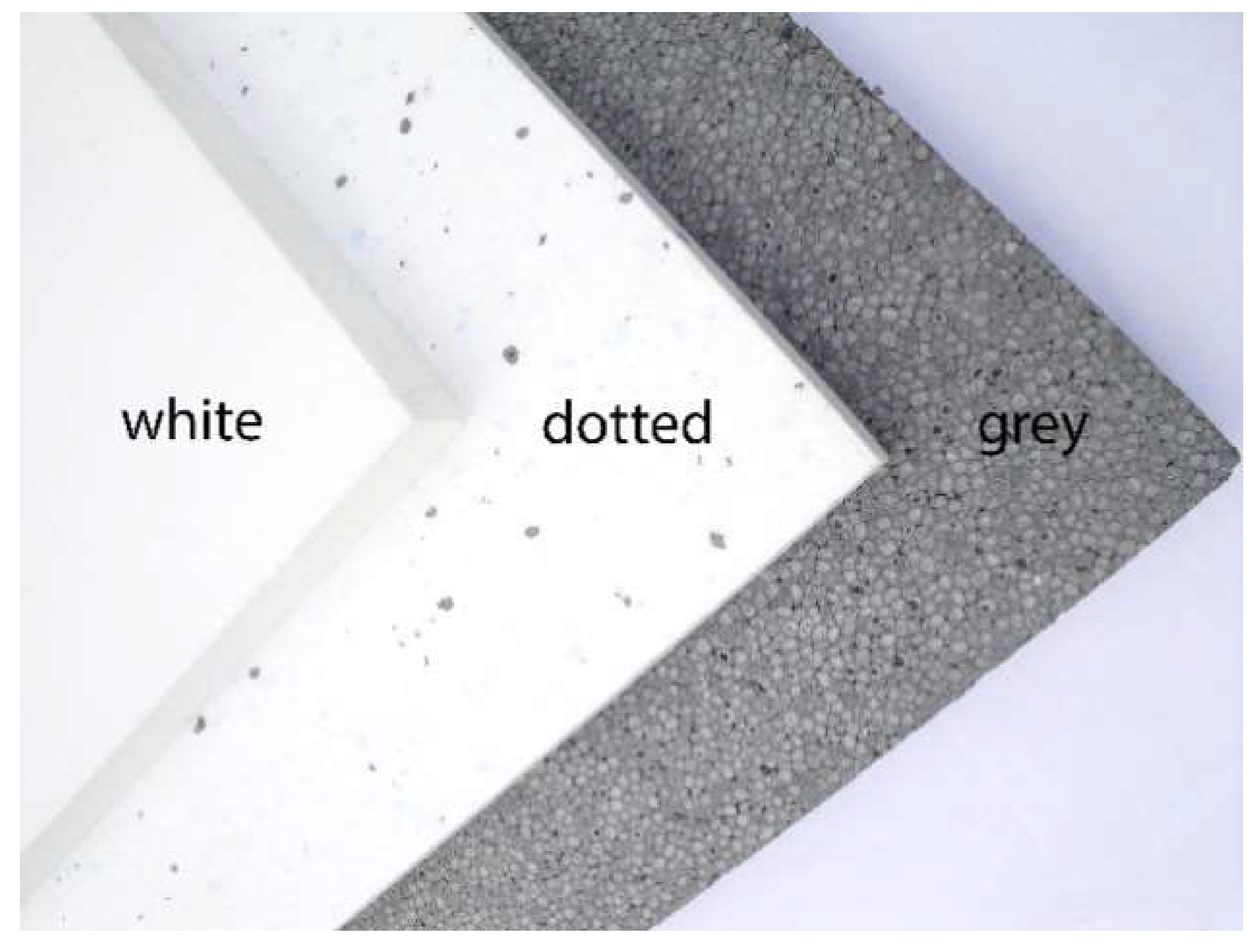

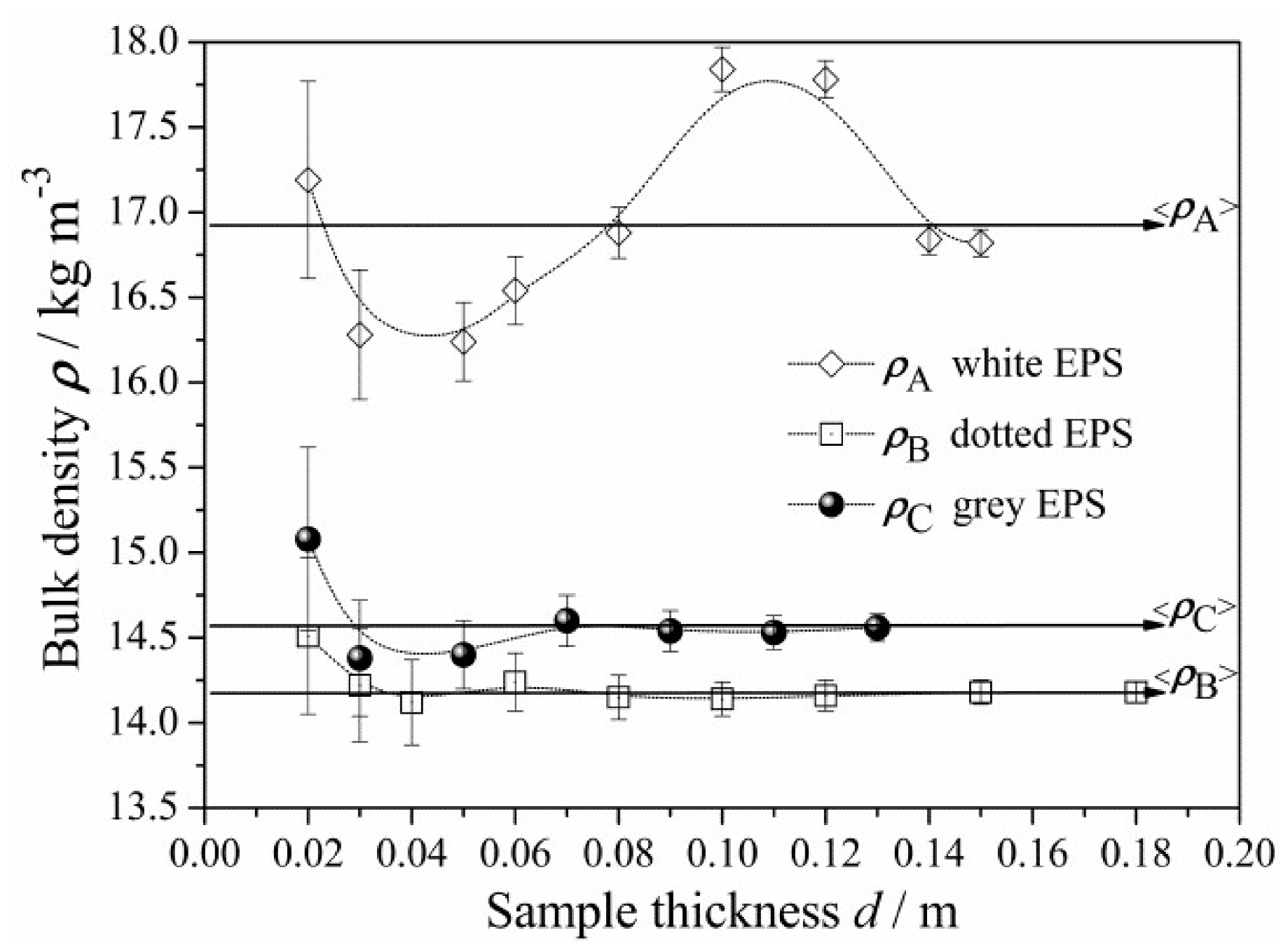
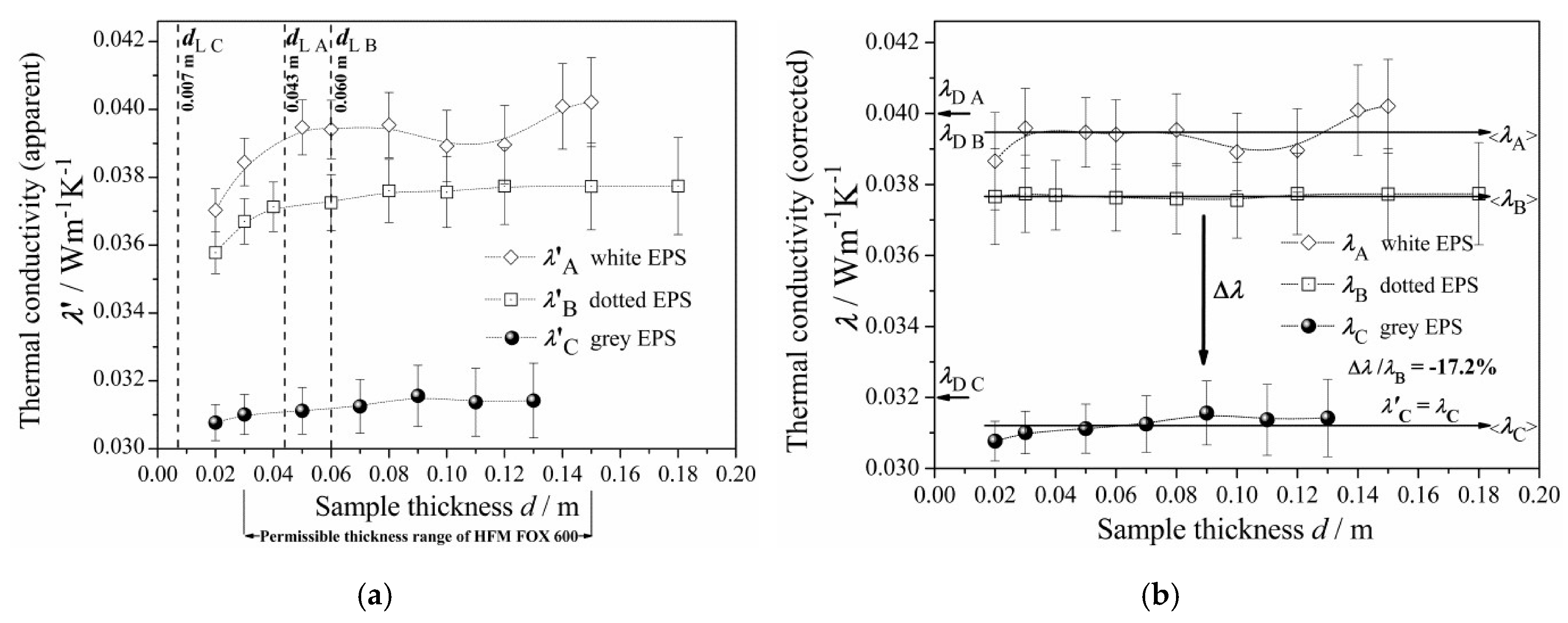
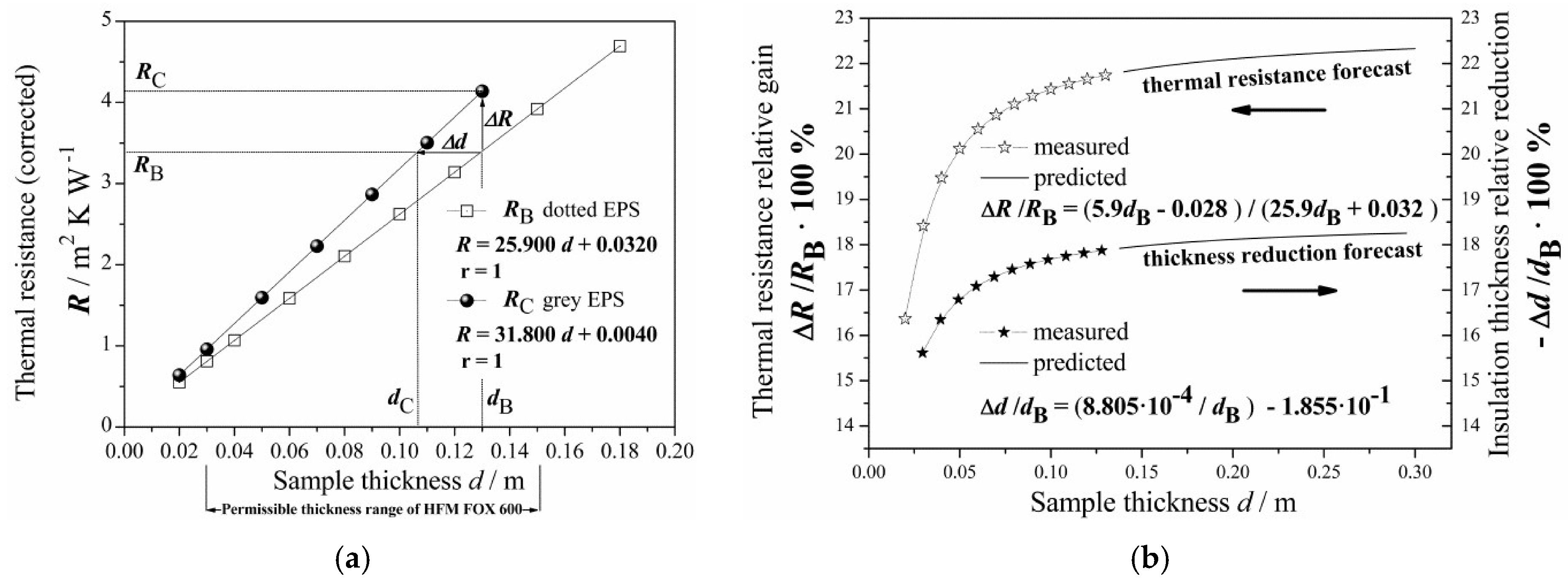
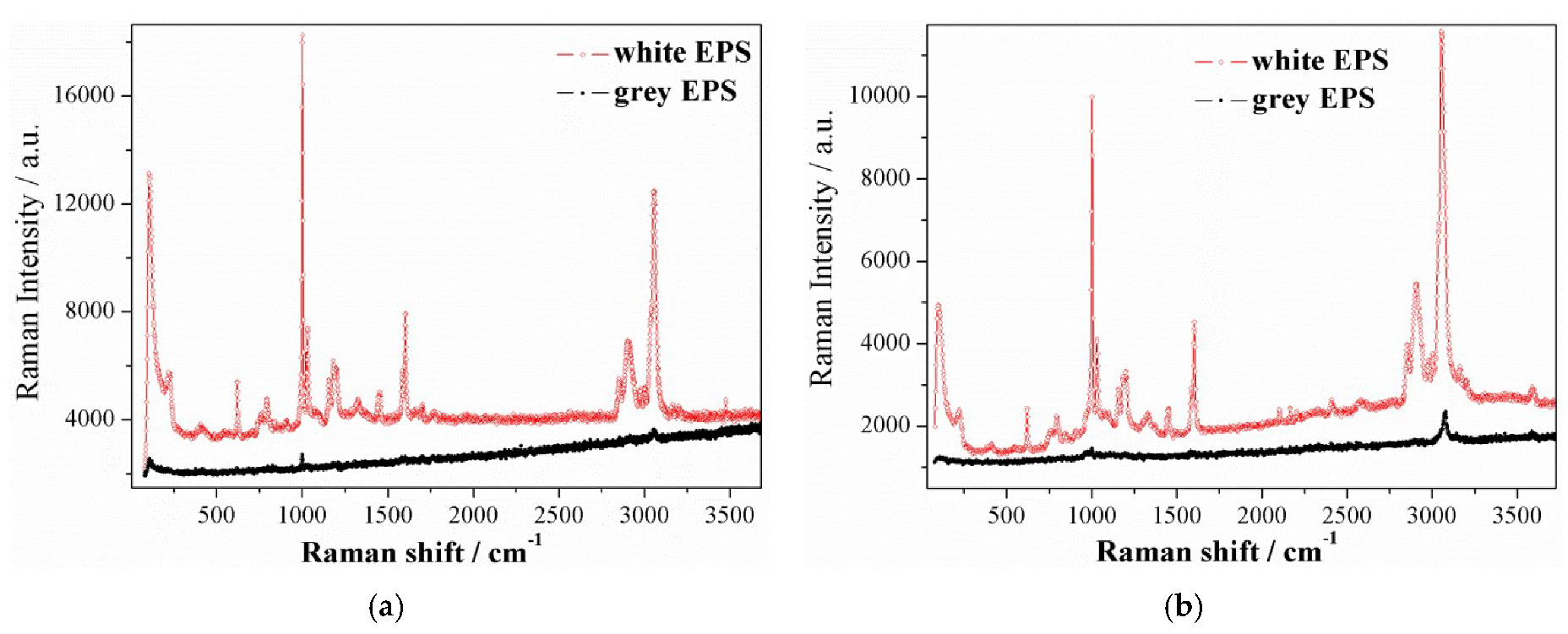
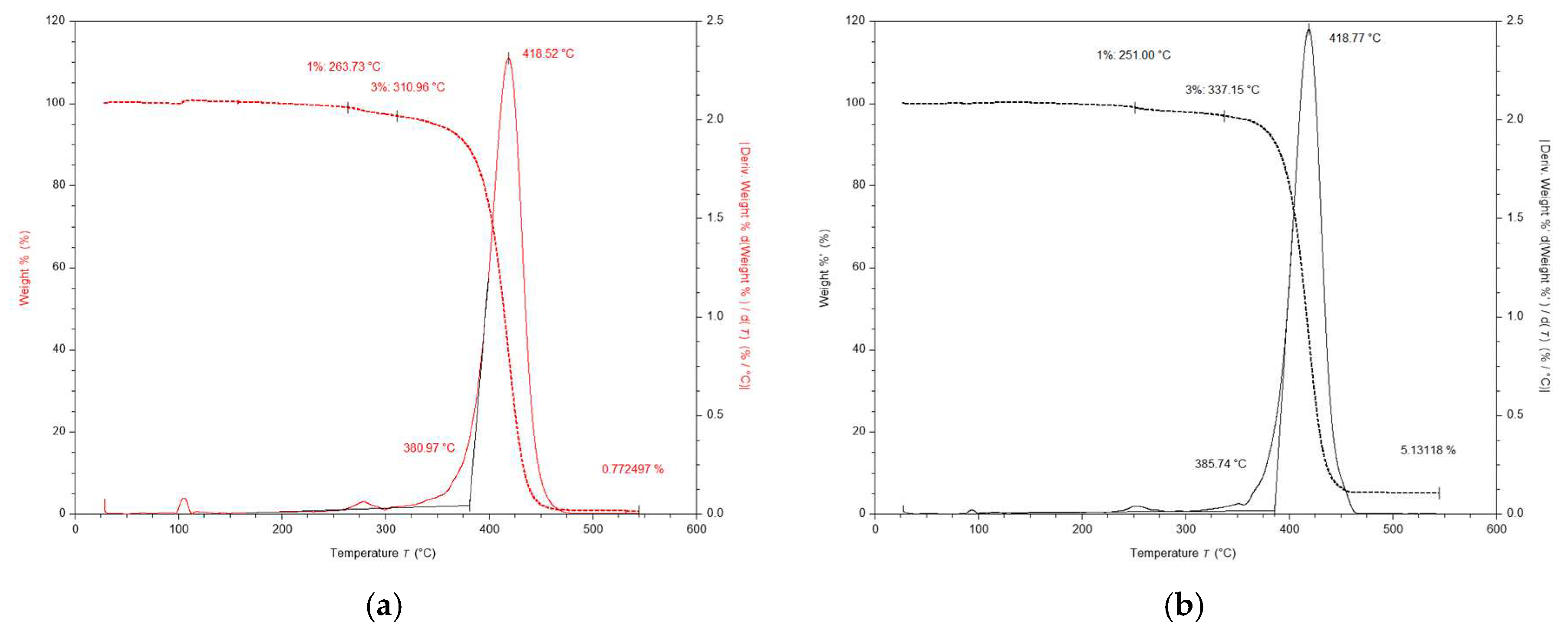
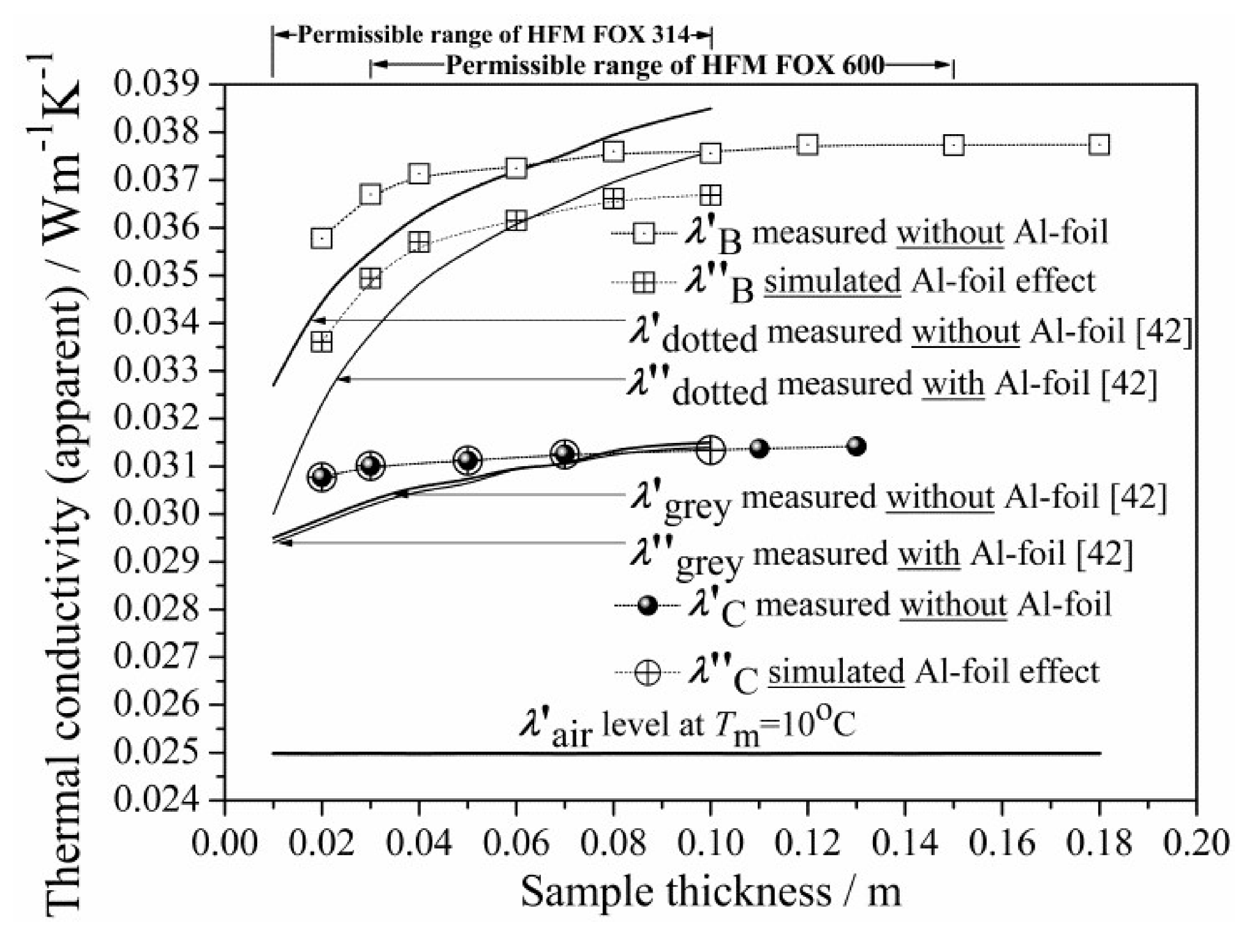
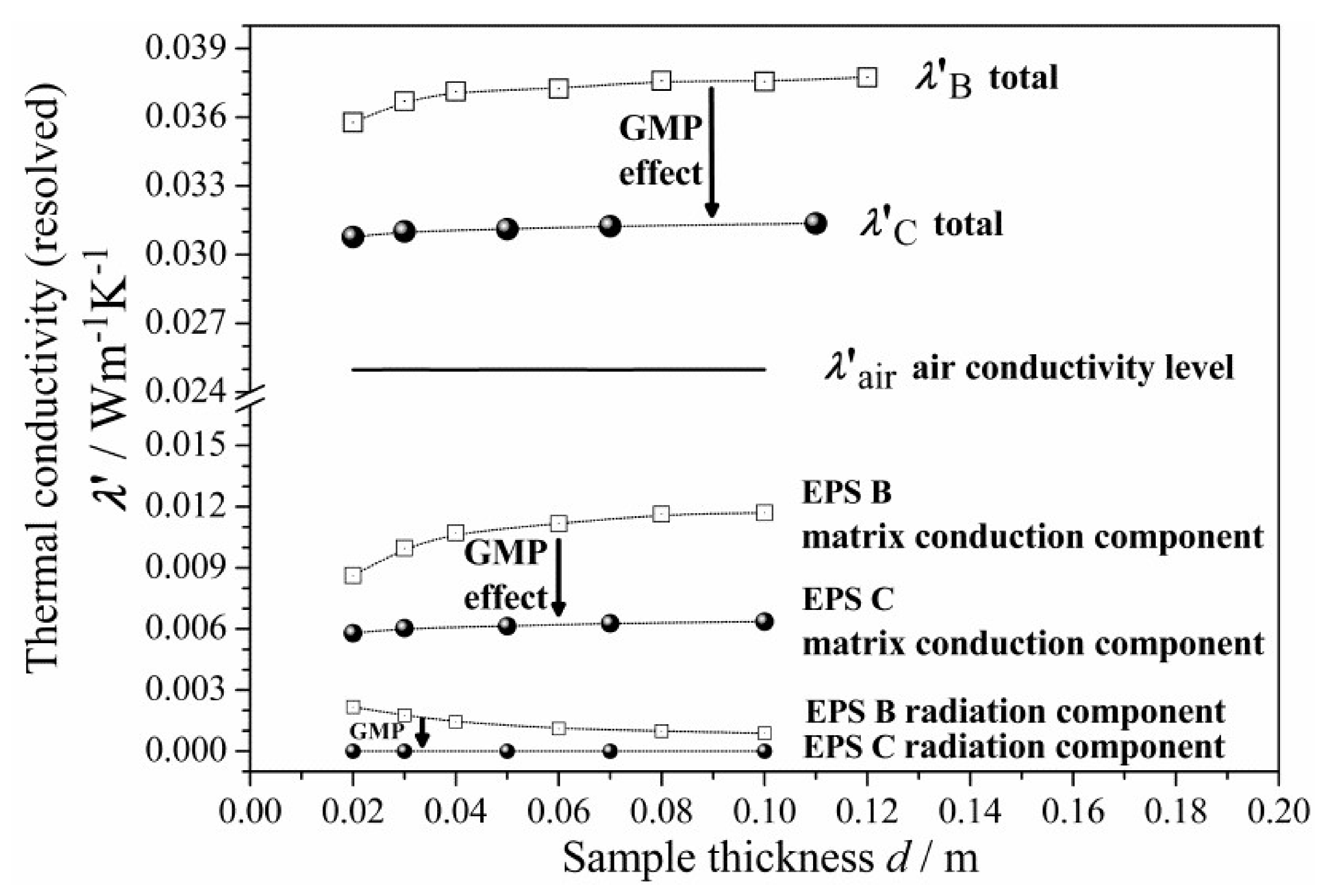
| SRM Type | SRM Dimensions (m) | SRM Bulk Density ρSRM (kg·m−3) Average Value given in the Certificate | |||||
| Length x | Width y | Thickness d | |||||
| Glass wool IRMM-440 | 0.500 | 0.500 | 0.0347 | 75.8 | |||
| SRM thermal conductivity coefficients at Tm = 10 °C (W·m−1·K−1) | Correction parameter at the coverage factor k = 2.0 = λCSRM − λMSRM (W·m−1·K−1) | Expanded uncertainties (W·m−1·K−1) | |||||
| λCSRM Average value given in the Certificate | λMSRM Average value measured by HFM FOX 600 | U(λCSRM) | U(λMSRM) | ||||
| 0.03048 | 0.03057 | −9 × 10−5 | 2.8 × 10−4 | 3.2 × 10−4 | |||
| EPS Type | Panels Mass Range (kg·10−3) | Panels Dimensions (m) | Bulk Density (kg·m−3) | Average Expanded Uncertainty <U(ρ)> (kg·m−3) | ||||
|---|---|---|---|---|---|---|---|---|
| <ρA> | <ρB> | <ρC> | ||||||
| Length x | Width y | Thickness Range d | Average Value with Double Standard Deviation ±2σ | |||||
| A “white” | 103.14–756.90 | 0.60 | 0.50 | 0.02–0.15 | 16.9 ± 1.2 | 2.1 × 10−1 | ||
| B “dotted” | 87.06–666.00 | 0.60 | 0.50 | 0.02–0.18 | 14.2 ± 0.2 | 1.8 × 10−1 | ||
| C “grey” | 90.48–567.84 | 0.60 | 0.50 | 0.02–0.13 | 14.6 ± 0.5 | 2.2 × 10−1 | ||
| EPS Type | Thickness Limit dL (m) | Thermal Transmissivity λt (W·m−1·K−1) | Thermal Conductivity Coefficients at Tm = 10 °C (W·m−1·K−1) | Average Expanded Uncertainty <U(λ)> (W·m−1·K−1) | |||
|---|---|---|---|---|---|---|---|
| λD | <λA> | <λB> | <λC> | ||||
| Average Value with Double Standard Deviation ±2σ | |||||||
| A “white” | 0.043 ± 0.010 | 0.0400 | 0.040 | 0.0394 ± 0.0010 | 1 × 10−3 | ||
| B “dotted” | 0.060 ± 0.005 | 0.0386 | 0.040 | 0.0377 ± 0.0001 | 1 × 10−3 | ||
| C “grey” | 0.007 ± 0.001 | 0.0314 | 0.032 | 0.0312 ± 0.0005 | 8 × 10−4 | ||
| EPS Materials | Low Industrial Concentration of GMP in the “dotted” EPS Materials | |||
| “dotted” EPS (Adapted)—Literature Data [42] | “dotted” EPS B (Tested)—Measured and Simulated Data | |||
| HFM instrument and test setup | HFM FOX 314 | HFM FOX 600 | ||
| Without Al-foil | With Al-foil | Without Al-foil | With Al-foil | |
 |  | |||
| HFM output as the apparent thermal conductivity coefficient | Measured λ′dotted (d) | Measured λ″dotted (d) | Measured λ′B (d) | Simulated λ″B (d) |
| EPS Materials | High Industrial Concentration of GMP in the “grey” EPS Materials | |||
| “grey” EPS (Adapted)—Literature Data [42] | “grey” EPS C (Tested)—Measured and Simulated Data | |||
| HFM instrument and test setup | HFM FOX 314 | HFM FOX 600 | ||
| Without Al-foil | With Al-foil | Without Al-foil | With Al-foil | |
 |  | |||
| HFM output as the apparent thermal conductivity coefficient | Measured λ′grey (d) | Measured λ″grey (d) | Measured λ′C (d) | Simulated λ″C (d) |
| Radiation | Air Conduction | Polymer Matrix Conduction | Radiation | Air Conduction | Polymer Matrix Conduction | ||
|---|---|---|---|---|---|---|---|
| Contribution (%) | Contribution (%) | ||||||
| Thickness (m) | Low Industrial Concentration of GMP in the “dotted” EPS Materials | ||||||
| “dotted” EPS (adapted)—Based on Literature Data [42] | “dotted” EPS B (tested)—Based on Measured and Simulated Data (in Brackets Corrected below dLB = 0.060 m) | ||||||
| 0.01 | 8.3 | 76.4 | 15.3 | - | - | - | |
| 0.02 | 6.1 | 72.2 | 21.7 | 6.1 (10.8) | 69.8 (66.3) | 24.1 (22.9) | |
| 0.03 | 4.8 | 70.4 | 24.8 | 4.8 (7.4) | 68.1 (66.2) | 27.1 (26.4) | |
| 0.04 | 3.9 | 68.8 | 27.3 | 3.9 (5.4) | 67.3 (66.2) | 28.8 (28.4) | |
| 0.05 | 3.5 | 67.9 | 28.6 | - | - | - | |
| 0.06 | 3.0 | 67.1 | 29.9 | 3.0 (3.9) | 67.1 (66.4) | 29.9 (29.7) | |
| 0.07 | 2.7 | 66.6 | 30.7 | - | - | - | |
| 0.08 | 2.6 | 65.7 | 31.7 | 2.6 (2.6) | 66.4 (66.4) | 31.0 (31.0) | |
| 0.09 | - | - | - | - | - | - | |
| 0.10 | 2.3 | 64.9 | 32.8 | 2.3 (2.3) | 66.5 (66.5) | 31.2 (31.2) | |
| 0.11 | - | - | - | - | - | - | |
| Thickness (m) | High Industrial Concentration of GMP in the “grey” EPS Materials | ||||||
| “grey” EPS (Adapted)—Calculated Based on Literature Data [42] | “grey” EPS C (Tested)—Calculated Based on Measured and Simulated Data | ||||||
| 0.01 | 0 | 84.7 | 15.3 | 0 | – | – | |
| 0.02 | 0 | 83.5 | 16.5 | 0 | 81.2 | 18.8 | |
| 0.03 | 0 | 82.4 | 17.6 | 0 | 80.6 | 19.4 | |
| 0.04 | 0 | 81.6 | 18.4 | 0 | – | – | |
| 0.05 | 0 | 81.4 | 18.6 | 0 | 80.3 | 19.7 | |
| 0.06 | 0 | 80.6 | 19.4 | 0 | – | – | |
| 0.07 | 0 | 80.6 | 19.4 | 0 | 79.9 | 20.1 | |
| 0.08 | 0 | 79.6 | 20.4 | – | – | – | |
| 0.09 | – | – | – | – | – | – | |
| 0.10 | 0 | 79.3 | 20.7 | 0 | ≈ 79.7 | ≈ 20.3 | |
| 0.11 | – | – | – | 0 | 79.6 | 20.4 | |
© 2020 by the authors. Licensee MDPI, Basel, Switzerland. This article is an open access article distributed under the terms and conditions of the Creative Commons Attribution (CC BY) license (http://creativecommons.org/licenses/by/4.0/).
Share and Cite
Blazejczyk, A.; Jastrzebski, C.; Wierzbicki, M. Change in Conductive–Radiative Heat Transfer Mechanism Forced by Graphite Microfiller in Expanded Polystyrene Thermal Insulation—Experimental and Simulated Investigations. Materials 2020, 13, 2626. https://doi.org/10.3390/ma13112626
Blazejczyk A, Jastrzebski C, Wierzbicki M. Change in Conductive–Radiative Heat Transfer Mechanism Forced by Graphite Microfiller in Expanded Polystyrene Thermal Insulation—Experimental and Simulated Investigations. Materials. 2020; 13(11):2626. https://doi.org/10.3390/ma13112626
Chicago/Turabian StyleBlazejczyk, Aurelia, Cezariusz Jastrzebski, and Michał Wierzbicki. 2020. "Change in Conductive–Radiative Heat Transfer Mechanism Forced by Graphite Microfiller in Expanded Polystyrene Thermal Insulation—Experimental and Simulated Investigations" Materials 13, no. 11: 2626. https://doi.org/10.3390/ma13112626
APA StyleBlazejczyk, A., Jastrzebski, C., & Wierzbicki, M. (2020). Change in Conductive–Radiative Heat Transfer Mechanism Forced by Graphite Microfiller in Expanded Polystyrene Thermal Insulation—Experimental and Simulated Investigations. Materials, 13(11), 2626. https://doi.org/10.3390/ma13112626




